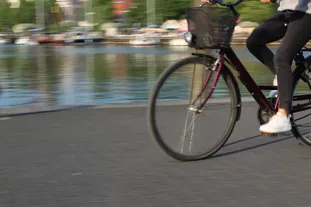SP2: Mobility



Head: Prof. Dr. Gebhard Wulfhorst
Affiliated PhD Student: Sindi Haxhija
Background
More than 50% of local trips can be realized by active mobility, while pedestrians and cyclists are specifically sensitive to the quality of the urban environment. Therefore, it is expected that UGI can enhance the quality of recreational destinations at a short distance, increase walkability within neighborhoods, improve cycling conditions along green corridors, and thus contribute to an enhanced quality of urban life. However, in accessibility research, there is still a lack of considering comfort in the criteria for the service of active mobility. Walking and cycling comfort is influenced by diverse factors, such as visual and aural stimuli, micro-climate and air quality, which are strongly related to the presence and quality of UGI. As the presence of UGI correlates with the mode share of active mobility, further investigations are necessary to understand these interactions and to achieve more sustainable mobility patterns. At the same time, the transport network structure can contribute significantly to the integration of UGI into urban environments. Synergies of climate change mitigation (a high share of active modes) and adaptation (preventing heat islands) in urban environments are crucial.
Objectives
The objectives of this SP are to:
- (O1) Review the potential of multifunctional UGI as ‘breathable corridors’ enhancing the attractiveness of ‘soft modes’;
- (O2) Analyze the relationships of UGI features and performance (network structure, biodiversity, pollutant reduction, cooling effect, etc.) concerning the impacts on walking and cycling comfort and the overall human well-being in urban areas;
- (O3) Examine the spatial and governance requirements for the creation of ‘breathable corridors’.
Main research questions (Q) are:
- (Q1) Which effect does UGI have on pedestrians and cyclists (mode choice, route choice)? How does this change depend on daytime and season (concerning illumination and weather conditions)?
- (Q2) Which direct impact, both positive and negative, do specific characteristics of UGI have on human comfort and well-being?
- (Q3) What are the requirements and potentials in mobility governance for creating added value of active mobility networks with respect to the development of UGI for attractive urban spaces and which conclusions can be drawn for its further enhancement?
PhD candidate: Mahtab Baghaiepoor
Dissertation: Understanding the interactions of urban green infrastructure and active mobility.
Methods:
Empirical research will be undertaken in stage 1 by user surveys, revealing the preferences of environmental factors on mobility behavior (depending on trip purpose, age, gender, etc.) to derive the requirements on the quality of the surrounding UGI (SP1). By linking the survey results with measurements of e.g., thermal comfort (SP7) and air quality, correlations between UGI effects and user perceptions can be quantified in stage 2. Moreover, expert interviews will help to identify the specific user needs to be included in planning processes. To generate transferable results, contributions towards a system model will link up the specific research question to the UGI framework. The findings will help urban planners to develop suitable green (blue) urban network structures that promote active mobility under the inclusion of all user groups, and at the same time enhance biodiversity and stormwater management. Related governance questions will be addressed in stage 3 by policy study and in different workshop formats, such as design workshops and to foster stakeholder cooperation in urban-transport planning processes.
Outlook:
In Period II, synergies between the network structure of urban streets and the connectivity of UGI will be investigated on the level of urban neighborhoods.
PhD candidate: Antonia Schauz
Overall aim:
Building on the investigations of the importance and influence of UGI on walking and cycling in selected street segments, we will shift the focus in this 2nd cohort on nodes and places.
We wish to take advantage of local amenities to shorten local trips, to shift them towards active modes of walking and cycling and to finally encourage people to “stay”, to enable and increase stationary activities. To “stay” as a free decision for local activities is one of the most sustainable mobility options. By this, we focus on the urban function of transport nodes.
The key objective of this research is to investigate the potential of urban green and blue infrastructure to turn transport nodes into livable urban places.
Potential research questions are:
To which extent can stationary activities take place in the immediate urban surrounding of mobility hubs? What are the consequences on mobility decisions?
How does the urban green and blue infrastructure influence the quality of stay at mobility hubs? Do people feel more comfortable at mobility hubs that are well integrated into the urban environment - what is the role of Urban Green Infrastructure?
What are the consequences on the purpose, the frequency, the duration of stay of stay (e.g. waiting, eating, mobile work, playing, relaxing)? What are the implications with appropriation of space, place-making, mobility behavior?
methods:
Based on literature review and expert interviews, we aim to develop a system model of key variables and interactions (causal-loop diagram) incorporating the transport functions and urban functions of mobility hubs. A diversity of selected sites will enable to conduct comparative empirical investigations such as (participatory) observation, mobility investigations as well as surveys and interviews with users of the hubs about their motivations and experiences in stationary activities at mobility hubs. The results of these investigations will be shared and discussed among the cluster 1 projects, and with the measurements of thermal comfort (e.g. SP7). We will analyze the qualitative and quantitative data in order to identify correlations between UGI effects and user behavior. The findings will be re-integrated into the system model in order to analyze feedback loops that will allow describing the potential of UGI to turn transport nodes into livable urban places, and to derive future scenarios of governance and practice application. Finally, open questions for further research will be addressed.